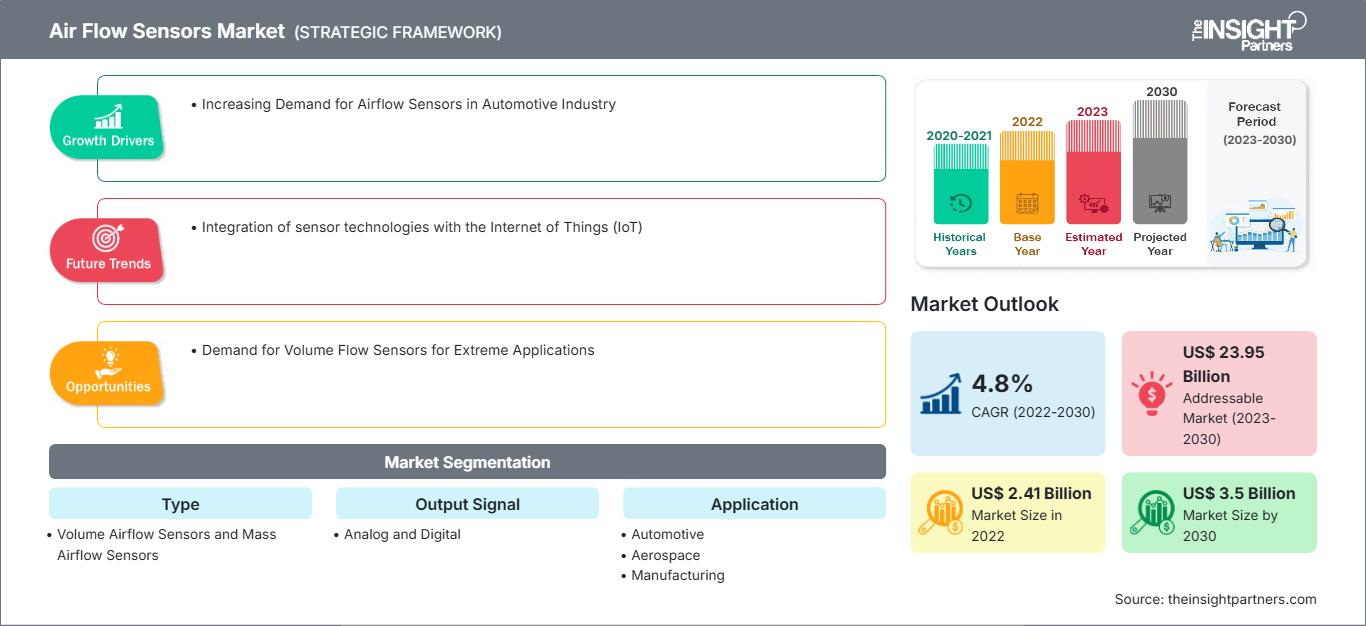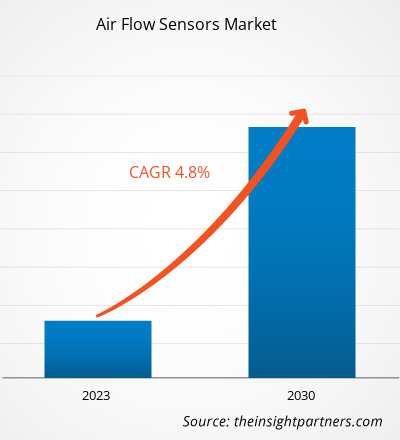Si prevede che il mercato dei sensori di flusso d'aria raggiungerà i 3,50 miliardi di dollari entro il 2030, rispetto ai 2,41 miliardi di dollari del 2022. Si prevede che il mercato registrerà un CAGR del 4,8% tra il 2022 e il 2030. L'integrazione delle tecnologie dei sensori con l'Internet of Things (IoT) rimarrà probabilmente una tendenza chiave nel mercato.
Analisi di mercato dei sensori di flusso d'aria
I sistemi HVAC utilizzano sensori di flusso d'aria per garantire un funzionamento efficiente e ridurre il consumo energetico. I sistemi HVAC sono dotati di sensori di flusso d'aria che consentono loro di confrontare la temperatura effettiva dell'area con una temperatura target e di adottare le misure appropriate. I controlli HVAC sono frequentemente impiegati in vari settori aziendali, tra cui ospitalità, aziende, commercio al dettaglio e residenziale.
Panoramica del mercato dei sensori di flusso d'aria
I sensori di flusso d'aria vengono utilizzati per determinare il volume o la massa del flusso d'aria in un canale. Esistono due categorie di sensori di flusso d'aria: i sensori di flusso d'aria di massa e i sensori di flusso d'aria volumetrici. I sensori di flusso d'aria sono facili da installare e misurano la pressione complessiva, la pressione statica del flusso d'aria e la velocità dell'aria. I sensori di flusso d'aria trovano applicazione in un'ampia gamma di sistemi industriali. Nei veicoli, i sensori di flusso d'aria sono fondamentali per mantenere livelli ottimali di efficienza del carburante e di emissioni e aiutano la centralina di controllo del motore a regolare l'iniezione di carburante per garantire una combustione efficiente.
Personalizza questo rapporto in base alle tue esigenze
Potrai personalizzare gratuitamente qualsiasi rapporto, comprese parti di questo rapporto, o analisi a livello di paese, pacchetto dati Excel, oltre a usufruire di grandi offerte e sconti per start-up e università
Mercato dei sensori di flusso d'aria: Approfondimenti strategici

- Ottieni le principali tendenze chiave del mercato di questo rapporto.Questo campione GRATUITO includerà l'analisi dei dati, che vanno dalle tendenze di mercato alle stime e alle previsioni.
Potrai personalizzare gratuitamente qualsiasi rapporto, comprese parti di questo rapporto, o analisi a livello di paese, pacchetto dati Excel, oltre a usufruire di grandi offerte e sconti per start-up e università
Mercato dei sensori di flusso d'aria: Approfondimenti strategici

- Ottieni le principali tendenze chiave del mercato di questo rapporto.Questo campione GRATUITO includerà l'analisi dei dati, che vanno dalle tendenze di mercato alle stime e alle previsioni.
Driver e opportunità di mercato per i sensori di flusso d'aria
Crescente domanda di sensori di flusso d'aria nel settore automobilistico per favorire il mercato
L'industria automobilistica è un importante utilizzatore finale di sensori di flusso d'aria. La crescente domanda di veicoli automobilistici determina contemporaneamente la necessità di sensori di flusso d'aria, poiché questi sensori vengono utilizzati nei motori e nei sistemi di scarico per monitorare e controllare il flusso d'aria. L'industria automobilistica è in rapida crescita in tutto il mondo. Inoltre, la penetrazione dei veicoli elettrici in tutto il mondo sta aumentando significativamente. Secondo la Commissione Europea, l'industria automobilistica fornisce posti di lavoro diretti e indiretti a 13,8 milioni di europei, pari al 15,1% dell'occupazione totale europea. Secondo le statistiche citate dalla Federazione Europea per i Trasporti e l'Ambiente, il governo del Regno Unito si è impegnato a raggiungere un obiettivo di emissioni nette pari a zero entro il 2050 e ha proposto il divieto di vendita di tutti i veicoli inquinanti entro il 2035. Pertanto, le iniziative per le emissioni nette pari a zero e la domanda di veicoli ecocompatibili tra i consumatori guidano il mercato dei sensori di portata d'aria.
Domanda di sensori di portata volumetrica per applicazioni estreme
Numerosi settori come quello automobilistico, aerospaziale, manifatturiero, energetico e dei servizi pubblici e altri richiedono sensori di portata volumetrica altamente performanti in condizioni estreme. Questo incoraggia gli operatori del mercato a sviluppare sensori di portata volumetrica per applicazioni estreme. Ad esempio, nel settembre 2023, ENVEA ha introdotto AirFlow P, una versione ad alta temperatura del sensore di portata volumetrica per applicazioni estreme. AirFlow P è un sensore per la misurazione del flusso volumetrico in sensori di carico di polvere, adatto per applicazioni ad alta temperatura fino a 800 °C.
Analisi della segmentazione del rapporto di mercato sui sensori di flusso d'aria
I segmenti chiave che hanno contribuito all'analisi del mercato dei sensori di flusso d'aria sono la tipologia e l'applicazione.
- In base alla tipologia, il mercato dei sensori di flusso d'aria è suddiviso in sensori di flusso d'aria volumetrici e sensori di flusso d'aria di massa. Il segmento del flusso d'aria volumetrico ha detenuto una quota di mercato maggiore nel 2022.
- In base all'applicazione, il mercato è suddiviso in automotive, aerospaziale, manifatturiero, energia e servizi pubblici e altri. Il segmento automotive ha detenuto una quota di mercato maggiore nel 2022.
Analisi della quota di mercato dei sensori di flusso d'aria per area geografica
L'ambito geografico del rapporto di mercato sui sensori di flusso d'aria è principalmente suddiviso in cinque regioni: Nord America, Asia-Pacifico, Europa, Medio Oriente e Africa e Sud e Sud America. America Centrale.
Paesi come Giappone, India, Cina, Australia, Singapore, Taiwan e Indonesia vantano una pletora di industrie manifatturiere, tra cui elettronica, alimentare e delle bevande, chimica, tessile, automobilistica e sanitaria. Inoltre, iniziative governative come "Made in China 2025" e "Made in India" danno impulso a queste industrie in diversi paesi dell'Asia-Pacifico, incrementando la domanda di sensori di flusso d'aria. Inoltre, la Cina vanta un'industria aerospaziale in rapida crescita. Un team di candidati tecnologicamente avanzati e giovani scienziati a Pechino ha svolto ruoli significativi in missioni come le sonde lunari Chang'e e l'esplorazione di Marte Tianwen in passato. Tali sviluppi nell'industria aerospaziale guidano la crescita del mercato dei sensori di flusso d'aria in Cina. Inoltre, la crescente consapevolezza dell'importanza del monitoraggio della qualità dell'aria rafforza la domanda di sistemi HVAC nell'Asia-Pacifico, a vantaggio del mercato dei sensori di flusso d'aria nella regione.
Approfondimenti regionali sul mercato dei sensori di flusso d'aria
Le tendenze regionali e i fattori che influenzano il mercato dei sensori di flusso d'aria durante il periodo di previsione sono stati ampiamente spiegati dagli analisti di The Insight Partners. Questa sezione illustra anche i segmenti e la geografia del mercato dei sensori di flusso d'aria in Nord America, Europa, Asia-Pacifico, Medio Oriente e Africa, America meridionale e centrale.
Ambito del rapporto di mercato sui sensori di flusso d'aria
| Attributo del rapporto | Dettagli |
|---|---|
| Dimensioni del mercato in 2022 | US$ 2.41 Billion |
| Dimensioni del mercato per 2030 | US$ 3.5 Billion |
| CAGR globale (2022 - 2030) | 4.8% |
| Dati storici | 2020-2021 |
| Periodo di previsione | 2023-2030 |
| Segmenti coperti |
By Tipo
|
| Regioni e paesi coperti | Nord America
|
| Leader di mercato e profili aziendali chiave |
|
Densità degli attori del mercato dei sensori di flusso d'aria: comprendere il suo impatto sulle dinamiche aziendali
Il mercato dei sensori di flusso d'aria è in rapida crescita, trainato dalla crescente domanda degli utenti finali, dovuta a fattori quali l'evoluzione delle preferenze dei consumatori, i progressi tecnologici e una maggiore consapevolezza dei vantaggi del prodotto. Con l'aumento della domanda, le aziende stanno ampliando la propria offerta, innovando per soddisfare le esigenze dei consumatori e sfruttando le tendenze emergenti, alimentando ulteriormente la crescita del mercato.

- Ottieni il Mercato dei sensori di flusso d'aria Panoramica dei principali attori chiave
Notizie di mercato e sviluppi recenti sui sensori di flusso d'aria
Il mercato dei sensori di flusso d'aria viene valutato raccogliendo dati qualitativi e quantitativi a seguito di ricerche primarie e secondarie, che includono importanti pubblicazioni aziendali, dati di associazioni e database. Di seguito sono elencati alcuni degli sviluppi nel mercato dei sensori di flusso d'aria:
- ENVEA, fornitore leader di soluzioni di monitoraggio ambientale, presenta l'ampliamento della sua serie di sensori AirFlow P con l'introduzione di una versione per alte temperature, in grado di resistere a temperature fino a 800 °C. Questa aggiunta amplia le capacità del sensore AirFlow P, rendendolo una soluzione ideale per applicazioni industriali ancora più complesse. (Fonte: ENVEA, sito web aziendale, settembre 2023)
- Posifa Technologies ha presentato l'ultima versione dei suoi sensori di flusso d'aria di massa, che saranno utilizzati nella terapia respiratoria e in altri ambiti sanitari e di strumentazione. I sensori delle serie PMF83000 e PMF86000 sono progettati per l'uso in ambienti difficili con umidità eccessiva e bassi livelli di gas corrosivi. (Fonte: Posifa Technologies, sito web aziendale, aprile 2021)
Copertura e risultati del rapporto di mercato sui sensori di flusso d'aria
Dimensioni e previsioni del mercato dei sensori di flusso d'aria (2020-2030) Il rapporto fornisce un'analisi dettagliata del mercato che copre le seguenti aree:
- Dimensioni e previsioni del mercato dei sensori di flusso d'aria a livello globale, regionale e nazionale per tutti i principali segmenti di mercato coperti dall'ambito
- Tendenze del mercato dei sensori di flusso d'aria e dinamiche di mercato come driver, vincoli e opportunità chiave
- Analisi dettagliata delle cinque forze PEST/Porter e SWOT
- Analisi del mercato dei sensori di flusso d'aria che copre le principali tendenze del mercato, il quadro globale e regionale, i principali attori, le normative e i recenti sviluppi del mercato
- Analisi del panorama industriale e della concorrenza che copre la concentrazione del mercato, l'analisi della mappa termica, i principali attori e i recenti sviluppi per il mercato dei sensori di flusso d'aria
- Profili aziendali dettagliati
- Analisi storica (2 anni), anno base, previsione (7 anni) con CAGR
- Analisi PEST e SWOT
- Valore/volume delle dimensioni del mercato - Globale, Regionale, Nazionale
- Industria e panorama competitivo
- Set di dati Excel
Report recenti
Rapporti correlati
Testimonianze
Motivo dell'acquisto
- Processo decisionale informato
- Comprensione delle dinamiche di mercato
- Analisi competitiva
- Analisi dei clienti
- Previsioni di mercato
- Mitigazione del rischio
- Pianificazione strategica
- Giustificazione degli investimenti
- Identificazione dei mercati emergenti
- Miglioramento delle strategie di marketing
- Aumento dell'efficienza operativa
- Allineamento alle tendenze normative




















 Ottieni un campione gratuito per - Mercato dei sensori di flusso d'aria
Ottieni un campione gratuito per - Mercato dei sensori di flusso d'aria